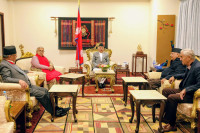Opinion
Attention policymakers
Our education system is still imparting skills taught to our forefathers or grandfathers
Hari Sharma
Discussions on improving the quality of primary, secondary and higher secondary education in Nepal have been going on since 1992, but there is little to show by way of results. A 1994 World Bank report entitled ‘Critical Issues in Secondary Education’ clearly exposed the shortcomings in our education system. But our system remained unmoved jeopardising the future of our youth. Secondary education is central to developing and modernising society, stimulating economic growth and improving agricultural and industrial productivity. Sadly, it has been understood very loosely by policymakers and development partners.
In a world where skill sets are changing semi-annually, our system is still imparting skills taught to our forefathers or grandfathers. The small share of the young population in higher secondary and university education is the outcome of our decades-old unaccountable education policy and mismanagement of public schools. If this trend continues, Nepal is unlikely to produce a labour force equipped with the skill sets and adaptability required to participate in modernising society. To graduate into the middle income group in the next decade, if not 2022, equal access to quality education should be our first national goal.
When we reflect on our national achievement in primary and secondary education during the last 15 years, we see a very depressing result. Although there has been a substantial improvement in the literacy rate since 1996, it still stands at 61 percent, with the urban and rural literacy rates standing at 77 and 57 percent respectively. Likewise, the literacy rate of the population aged 15 and above is only 57 percent. It is likely that the percentage of the population having skills is marginal.
Current scenario
Disparity with respect to region and gender is wide and deeply rooted. Rural Tarai-Central has the lowest literacy rate of 38.5 percent followed by the mountain region with 47.5 percent while urban Kathmandu Valley has a high 84.3 percent. Similarly, the female literacy rate is a meagre 44.5 percent in comparison to the male literacy rate of 71.6 percent. In terms of age group, only 54.6 percent of the population in the age group 15 years and above has ever attended school. The figure for females is only 42.9 percent against 69.6 percent for males. These statistics are a manifestation of our unproductive education system, which does not benefit the country.
The dropout rate at the secondary and higher secondary levels is still very high and increases with the age of the students. A higher dropout rate is observed in the most productive age bracket of 15 to 24 years. This implies that most of the primary students are not able to continue into the secondary or higher secondary level. These early dropouts do not have a set of skills to participate in the labour market. They are forced to do manual labour and either migrate to India seasonally or to the Gulf countries.
A continuously poor SLC pass rate provides strong evidence of the failure of our education policy to meet a very modest educational need. Most public schools have very poor amenities. Facilities such as drinking water, toilet, sanitation, library, science lab and electricity are rare. Government schools do not have female-friendly toilets. Lack of female-friendly toilets is one of the major reasons for the high female dropout rate in South Asia. During menstruation, girls often abstain from attending school due to very unequal social norms and lack of toilets or their miserable state.
The bigger picture
The quality and effectiveness of the teachers, which is key to quality education, is questionable. In most public schools, teachers attempt to teach subjects in which they are not specialised due to their inadequate number. The government itself does not know how many teachers are available for each subject. Subject teachers, especially in science, maths and English, are lacking. Too many subjects are offered (eight subjects in SLC) instead of focusing on essential subjects to develop core competence. School textbooks are designed poorly, and the fairness and reliability of the examination have been questioned. Under-qualified and untrained teachers are also contributing to the dropout rate. Inadequate pay, temporary teaching positions and rising cost of living are failing to attract qualified teachers, especially in rural areas.
The performance of private schools is way better than government and community-managed schools. The composition of the fees and charges of private schools are about 10 times higher, therefore, they are able to serve only a minority of the students who come from the top income group. Public schools are not producing skill sets needed in the private sector while private schools are competing to match the curriculum of the developed world. Therefore, the number of students intending to migrate has been swelling in recent days. The education sector is always underfinanced, and over time, the share of education expenditure in secondary education has been declining. Out of the total education expenditure, 75 percent is spent on the salaries of the teachers and administration costs.
At the macro level, the major challenges for the government of Nepal are improving institutional efficiency and quality of input, achieving equity and equal opportunity in secondary education and addressing the growing need for secondary education and financing it. Some of the shortcomings at the micro level can be addressed by diverting resources from low performing schools where there are few students to high performing schools. School management can be improved by giving some autonomy with regard to decision-making and designing incentives for better performing schools. In order to ensure that subject teachers are adequately qualified, political networking and intervention should not be allowed in the recruitment process. Where qualified teachers are not available, ICT (information and communications technology) should be provided and its use promoted in the teaching-learning process.
Sharma is a research fellow in economics and holds a postgraduate degree from the Asian Institute of Management, Manila




 19.12°C Kathmandu
19.12°C Kathmandu











